Surprise Mountain Lookout Site
This page is devoted to Surprise Mountain and the former fire lookout. For access information, see the link to the left. In 1934, photos were taken from the summit as part of the government Osborne Photo Survey. At that time, no structure existed but a lookout cab was built shortly after the images were taken, I'm guessing 1937. The building was an L-4 cab that was likely destroyed in the 1950s.
We learn some information about this lookout from the Mountaineer Annals of 1943. Headed by Helen Rudy, club secretary, Surprise Lookout was organized and manned for the summer. "Many members visited Surprise that summer to see how the Mountaineer volunteer fire spotters were getting along at that post". For the next decade, Surprise Mountain was a popular destination for mountaineer trips.
Washington Lookout Sites
Related Information
"SURPRISE to Evergreen - Surprise to Evergreen - Come in Evergreen." Thus at 7:45 a.m. the first radio report began the official day on Surprise Mountain Lookout, elevation 6,300 feet, though duty had unsnuggled the observer from the Forest Service sleeping bag hours earlier at the first streaks fo red and gold across the eastern ridge-well, maybe not the first streaks.
A manpower shortage had induced the U. S. Forest Service to place women on some of their lookouts and to experiment with one or two stations on a cooperative basis. In lin with the latter the Mountaineers agreed to "man" Surprise Lookout near Scenic, Washington, for the season, July 10 to August 31, an daccordingly nine people were signed up in one and two week shifts. Faye Plank, who drew the first week, bore the brunt of cleaning up the winter's accumulation of debris as well as shouldering the responsibility of buying and apportioning the summer's food. Supplies were carried in the 7.25 miles from Scenic by pack-train.
N.L. Jeremias, his wife and their little cocker spaniel kept watch for the remaining two weeks in July, followed by Mary Lowry's party, consisting of her son, Larry, and her cousin, Ena Tiemeyer, the weather dishing out everything from blistering sunshine to snow for them. By the time Mrs. Herman Felder and her daughter, Virginia, took over, some needed repairs had been made to the cabin and equipment by the Forest Service, adding a measure of comfort and convenience.
Those who teamed up with one or more companions were able to enjoy exploration or fishing trips or a swim in one of the lakes in addition to their regular duties, but for the lone attendant these duties nearly filled the day's hours. The lookout was not to be left unattended without permission of headquarters and a detailed check of the territory had to be made every hour starting with the "crack of dawn" which was often the only time the atmosphere was free from haze. Every two hours a report was turned in via short-wave radio to one of the other lookouts: Evergreen, Beckler or Benchmark. This message was relayed by telephone to headquarters since Surprise did not have a direct connection with the Ranger Station in Skykomish. Conversations were usually confined to business and , of course, all reference to weather was taboo. Helpful suggestions passed back and forth, however, such as Mary Lowry's recipe for cinnamon rolls which made the man on Evergreen so envious he decided to try his hand and making cream puffs for dinner. The result was never broadcast!
The first and most important item on the day's schedule was to check and balance the firefinder which, however, usually remained in balance from day to day unless unduly jarred. The two clocks in the lookout being ever at variance, the time had to be checked morning and evening, also. Then drinking water had to be fetched from a stream a mere mile and a half away and wash water from a snow patch which by August had receded to Surprise Pass, three-quarters of a mile down the trail. With caution and careful sifting of the dishwater a lone lookout need make the trip only every third day. The first hint of an electrical storm sent the observer scurrying back to her post as each visible strike had to be recorded and checked.
And finally there was Debroah, the name given here to the chunky little piece of malleable iron formally known as a stove, though during the summer it had other, less affectionate names. Debbie's reputation had gone before her and when people asked with wide-eyed apprehension if I weren't afraid of possible wild animals, I truthfully answered, "No, only of Debroah."
It turned out later that I was also afraid of crickets. I shall never forget however, the feeling of absolute "ga-ga" when the Herman Felders disappeared into the dripping fog leaving me alone with cold Deborah. Especially when after several attempts it seemed that Deborah preferred to remain cold, which meant that I would also. A new door and a little understanding were all that were necessary, though. Her grate was for coal and our fuel was wood, so by a careful laying of the fire with wood dried in the oven at the preceding meal, and an occasional low salaam wherein I shared my life's breath through the grating, we became at last fairly warm friends.
The forest Service had obligingly supplied a couple of saws, a decadent tree or two, and a doubled-bitted ax to keep us from getting flabby. One would rotate the ax at each stroke to determine which edge was the sharper - something like trying to find the long way of a square blanket - but since this first person singular only hit the target with every other heave the question was never settled. The season was supposed to begin and end with a rick of neatly stacked stovewood but somehow by the middle of August there remained a neatly stacked five hunks. One glancing blow at their gnarled surfaces was enough. They are still there.
Often the question is asked if there weren't a lack of incentive to cook for one only. The incentive was primal: I got hungry. The difficulty was in keeping portions small. Quantities that looked minute in the raw attained amazing proportions when amalgamated into a meal. Also, most canned goods were in large tins which meant that string beans opened on Monday were quite a familiar sight by Wednesday. So it was that Thursday produced the piece-de-resistance: Surprise Borsch-the "Lost Chord" of the culinary world, since nothing like it had ever been concocted before or since. Which is probably just as well.
Although deer had been sighted practically at the doorstep of the cabin, the only wild animals I saw were some bashful chipmunks and a grandfatherly looking marmot. Gramp rented the basement apartment and evidently worked the graveyard shift because at 12:30 a.m. there would resound from below such a tearing about and banging as could only have resulted from a marmot Dagwood making for the last bus.
I have made no attempt to describe the building in detail, since lookouts are pretty much the same everywhere. As to the scenery, your eyes would be a better camera than my pen. Dominated by Glacier Peak slightly to the northeast, the view is shortened on the east and south by Thunder Ridge and the expanse of Mt. Daniels and Hinman Glacier, broadening out again to the west to include the Olympic Mountains adn sweeping on across so many familiar peaks northward to Mt. Baker. Directly at the foot of the 1,000-foot promontory on which stands the lookout cabin are two of the loveliest little lakes imaginable and by no more than a turn of the head four others are visible.
Appreciation is especially extended to Mr. A.R. Evarts of Seattle, Mr. Cooper, head Ranger at Skykomish, and Mr. Lake, whose many courtesies added to the pleasure of the work. Altogether it was a most enjoyable vacation. Though we had to walk three miles for water, cut our own wood and keep an ever vigilant eye out for wayward smoke, the trail to Twin Lakes, our "water-hole," was especially pretty and would have been traveled many times even if we had been left to our own devices; the chores were good for both muscles and disposition, and with scenery such as we had one just naturally was ever on the look-out anyway. I hope the Forest Service will call on us. My sincere hope, however, is that such substitutions will not long be necessary and that the men who love the mountains and belong in them will soon be back. Until then, this is - Surprise clearing.
Lookout Above by Helen M. Rudy In 1943.
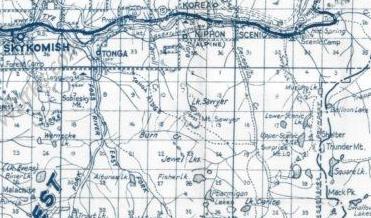
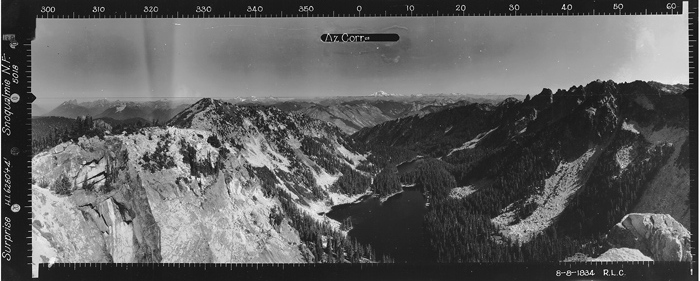
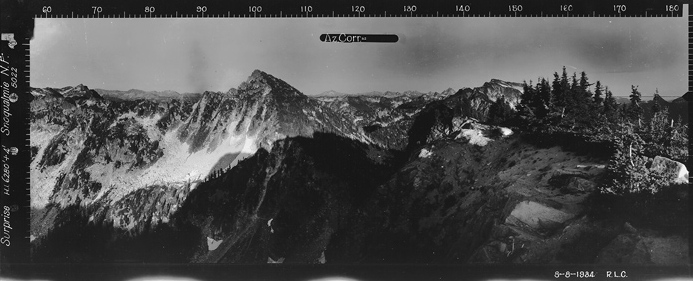
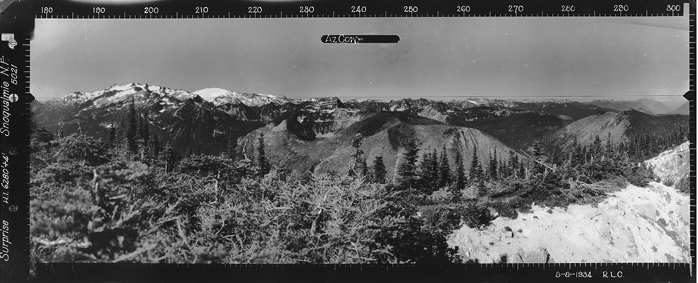
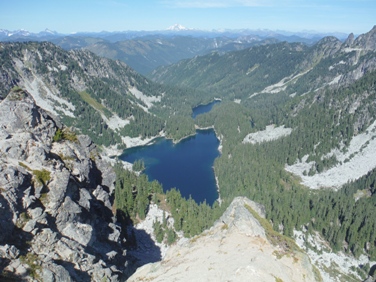
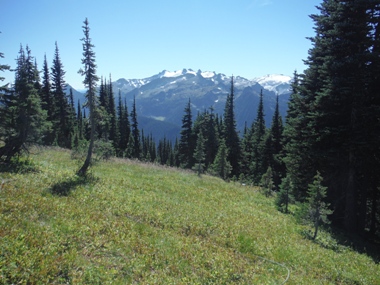
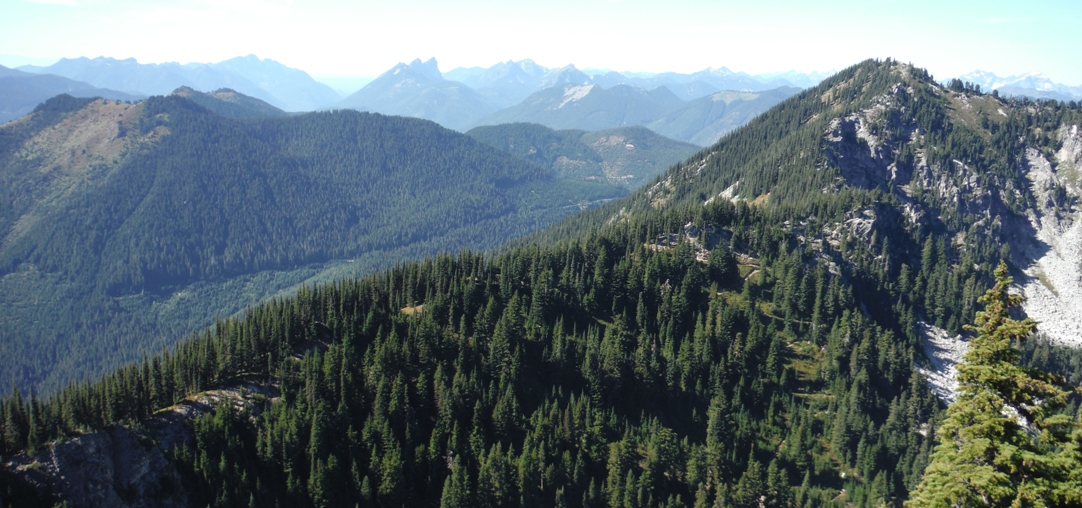
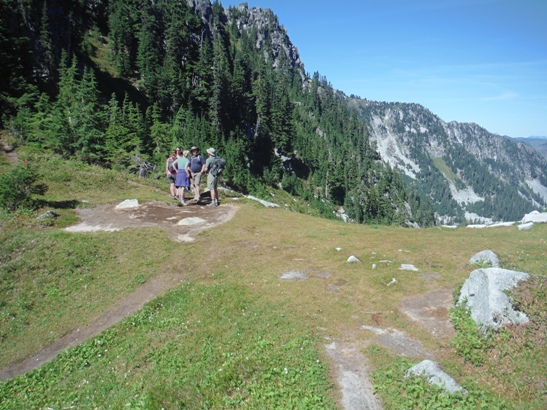
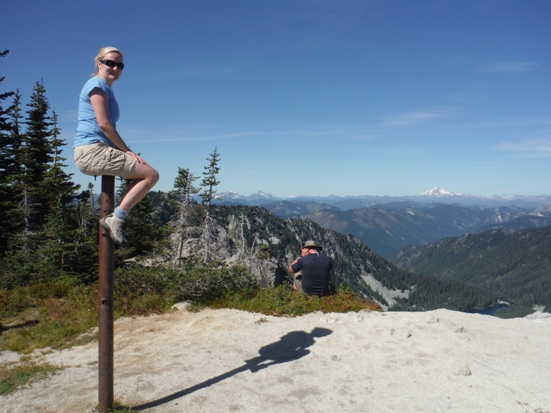
Few maps show the lookout, this one is a 1940 King County Metsker Map.
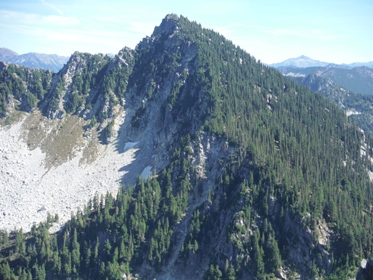
Liberation Peak
Southeast 1934
Southwest 1934
North 1934
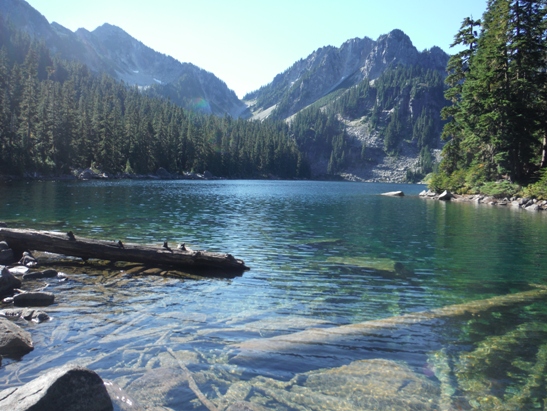
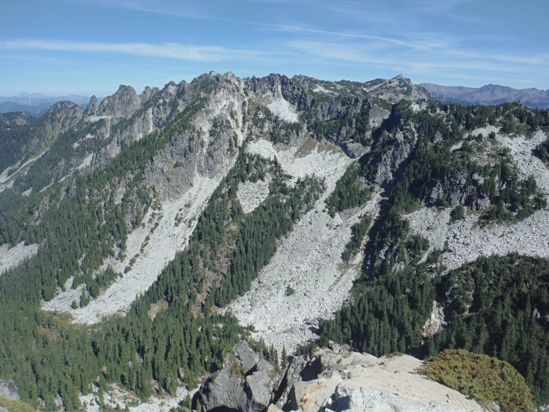
Mount Daniels now known as Mount Daniel
Glacier Lake & Surprise Lake
Spark Plug Mountain
Tonga Ridge
Mount Baring
Mount Index
Beckler Peak
Looking Northwest (note that it can see the Evergreen Mountain Lookout)
Evergreen Mountain Lookout
A piece of the lookout remains 2014
At Surprise Gap, the source of snow melted water for washing stuff
Surprise Mountain (on right) from Glacier Lake
Looking NE to Thunder Mountain
More Information











